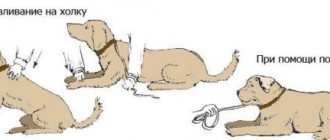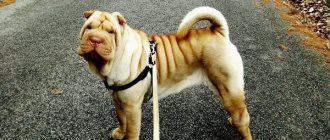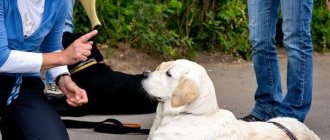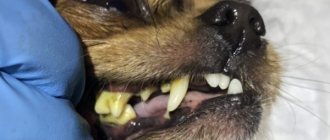Why do you need to teach your dog the “face” command?
The “fas” command is used for self-defense in the event of an attack on the owner by an attacker. If the dog is trained to attack on command, his actions in the future can save your life or at least preserve your health.
Also, in the event of theft, with the command “front” the dog will be able to catch up and detain the criminal until you arrive.
Service animals are taught this exercise from childhood, but this skill is also quite learned by pets. The main thing is to approach the training of the animal responsibly, taking into account all the small details.
Precautionary measures
Training is carried out in a fenced area away from passers-by. The assistant’s body must be covered with protective clothing, and his face with a special mask. Only the eyes are left visible. This is necessary to identify emotions.
A harness or halter is put on the animal, since sudden jerks in the collar can lead to injury and suffocation. Attacks are encouraged exclusively on the sleeve. The face, neck and groin should remain off-limits for bites.
Features of training
- Before you start training your pet as a serious command, you need to realize whether you are ready to take on such responsibility, because if you make mistakes in training, it will be difficult to avoid irreversible consequences.
- To avoid the risk of aggression in an animal towards people or animals in everyday life, it is recommended to periodically visit a dog handler so that he, seeing the shortcomings in reality, can help you correct them. If the dog trainer sees that you are training your pet incorrectly, he will direct you in the right direction.
- Not all dogs are capable of learning the “face” command. Training depends not only on the breed of the animal, but also on its psyche and character. You cannot teach the “face” command to a dog with a weak nervous system (such dogs are cowardly and overly emotional). It is strictly recommended to train an aggressive animal with the help of an experienced dog handler, since you yourself can only aggravate the situation.
- Before learning the “Face” command, the dog must know the basics of the general training course. The main thing is that the dog respects the owner and does not violate boundaries, and also clearly understands the meaning of the “fu” and “no” commands.
- It is impossible to learn the "fas" command alone. You will need an assistant in a specialized protective suit.
- In addition to training, do physical training with your pet. Build strength and endurance in your animal, develop muscles. At a minimum, you should take your dog for long, active walks. You can also give your pet trotting and swimming exercises to improve physical fitness.
It is important not to overdo it and adequately dose the load for the animal. Of course, the dog must be healthy.
Patience comes first!
If you are planning to buy a pet, the best option would be advice from a dog handler. The master will certainly tell you which breed is best for you. It happens that people take an animal straight from the street, for example, they feel sorry for a homeless puppy or an adult dog.
The challenge will be to toilet train your pet. It is impossible to punish a dog with a “whip”, it will work against the owner. In order for the dog to listen and, most importantly, understand, you will need:
- remain patient;
- have perseverance;
- show affection.
These three parameters are extremely important in raising an animal! Especially in taming street dogs. Remember, street pets are much more difficult to train.
Carpets will have to be removed from the floor; dogs prefer soft coverings as a “toilet”. If the dog is large, the toilet is outside. It is necessary to develop a certain “toilet” routine for your pet. If successful, the pet will try to endure it until the walk or will begin to whine, asking for time off to “go to the toilet.” If the dog is small, for example, a Spitz or a Chihuahua, it is possible to organize a toilet at home. You will need to purchase a special tray and fill it with sand or filler.
To ensure that your dog goes to the toilet at home only in the specified place, soak a cloth in urine and place it in the desired place. As a rule, animals smell the smell of a “toilet” and instinctively choose the “smelling” place. It is possible to monitor the dog; if you try to settle in the wrong place, move it to the right one. Try to contain negative emotions if your pet “goes to the toilet” in an inappropriate place. Remember, the desired result does not come quickly. Small dogs also need to be walked; it is permissible to refrain from walking only in case of severe frost, gusty winds or heavy rain.
As you know, dogs love to chew, especially puppies. Don't scold your kids for chewing on their slippers or wires. Probably, the body requires such an exercise: there are not enough vitamins or the teeth are simply itchy. Buy special bones, sold at a pet store. It is possible to offer simple bones from cooked soup. Slippers and wires should definitely be removed and hidden from the pet’s eyes.
Where to begin
First of all, think about whether your four-legged dog will be able to learn the “face” command. If you have a gentle and soft pet that does not hold any pressure and, if something happens, can get scared and squeeze, it is unlikely that he will be able to really protect you in a moment of danger.
The “Face” command should be taught to dogs with a strong, stable psyche.
Find an open area with a tree or pole to which you can tie your pet. Under no circumstances should the dog be wearing a collar, as during the training process the animal will strongly pull and tear. To keep your pet healthy, wear a harness while training.
Practicing a skill in different situations
After the basics have been established, they begin training to assess the situation. The pet is trained to protect not only the owner, but also the rest of the family, as well as their personal belongings. In case the attacker retreats, they are working on pursuit and arrest techniques.
Methods of attack are adjusted depending on the type of weapon. If the attacker has a knife in his hand, then the four-legged defender attacks in the area of the armpit of the occupied hand, and if a gas spray or stun gun, then from the back.
Stages of training
Puppy training
You can start laying the foundation for a puppy from the age of 1.5-2 months. Of course, there can be no talk of any manifestation of aggression, much less an attack.
At this age, it is necessary to work with the puppy to strengthen the prey instinct. To do this, you need to take a toy and act out your pet.
Play a little every day, ending at the most interesting moment of the game. The dog must chase and pull the toy.
It is important to let the dog win in the fight so that he does not lose interest in the activity.
Offer your animal a variety of toys, including all sorts of rags, grips, and whatever your imagination allows.
The pet's grip should be strong enough, that is, he should hold the toy tightly and not intercept it while tugging. To strengthen your grip, make your dog feel more confident by allowing him to win more, and also develop an interest in the game.
It is important to teach the animal the skills of “give” and “fu” - the dog must unquestioningly follow these commands. By the time you reach one year, you can move on to the next stage of training, which involves training an adult animal.
Training an adult dog
Let the dog get acquainted with the territory of the lesson, then take the animal on a leash and tie it to a tree. Make sure your pet is not confused or distracted by anything.
Stand to the side of the animal so that its body is near your left leg. The dog must sit or stand.
Call the assistant - the person involved. Start saying “stranger” in a provocative tone. Even if the dog doesn’t yet know the meaning of the word, this is necessary to create an association with the “fas” command in the future. The word “stranger” will be a signal for the dog to follow the command “front”.
Ask your assistant to move in strange, hesitant movements. The person involved should also take a rag and wave it, moving towards the pet. A tight leash will further provoke the dog to show aggression. If you feel that the dog is tense enough, and the helper has approached close enough, make a sharp lunge forward and give the command “front”. The dog should rush towards the person and tear the rag or protective sleeve. Praise your dog verbally. After a few seconds, command “fu” and take the dog back to the tree. Repeat this several times.
Untie your dog from the tree, but do not let him off the leash. The animal should be near your left leg. Ask your assistant to move 3-5 meters away from you, also moving in a strange way. As soon as the dog tenses up, make a sharp lunge forward, giving the command “front”. The dog must run to the person involved and grab him. After a few seconds, give the command “fu” and take the animal away. Repeat this several times.
Ask the person involved to run away from the dog, and after placing the dog at your left leg, at the moment of tension, lunge forward and give the command “front”. The dog must catch up with the person involved and grab him, after which you come up and give the command “fu”.
Once you are convinced that the dog clearly releases the helper on the “fu” command, you can work without a leash. Train in different environments and under unforeseen circumstances, bringing the situation as close as possible to the real one. Only then will the pet really be able to protect you in the event of a real danger.
Trick for the enthusiast
If you want your dog to be able to crawl, roll over, “serve,” walk on its hind or front legs, and perform other circus tricks, you should make the training more difficult. It is worth starting such training only when your pet has mastered all the basic commands.
To teach your dog to roll or turn, dangle a treat in front of his nose, and then turn your hand so that it is comfortable for the animal to spin along the same trajectory. Interesting, unusual teams will require a lot of endurance from you. The result will delight both you and your guests, and your adult pet will learn how to perform mini-circus performances at home.
Possible mistakes
- Continuation of work if the dog begins to show cowardice or uncertainty. Do not work with a pet who is not confident, otherwise, with the wrong approach, you will only aggravate the situation. You must work on the animal's stability before you begin teaching the "face" command.
- Manifestation of excessive emotionality. Do not scream or make too loud or emotional sounds, otherwise the dog will regard this as panic and will not show the desired reaction. You must act confident.
- The pronunciation of the command “alien” is just like that . Don't make your pet nervous for no reason. If you tell your dog “stranger” for fun, it may begin to show aggression towards others. In addition, over time, the pet will get used to this word and begin to ignore it.
Popular question
Will the dog become aggressive towards others?
If you follow all the rules of command training, the dog will not rush at others for no reason.
For prevention, it is recommended to periodically visit a dog handler. Also, if you notice on walks that the dog begins to at least become wary at the sight of passers-by, distract the dog with food or toys.
In this case, you also need to visit a specialist to work out this point.
General training course for a competent dog
The concept of a literate dog defines a dog that knows the initial commands and carries out orders at the request of the owner. Agree, you don’t want to have a stupid, ill-mannered individual in your house. However, there are no stupid animals, but there are lazy owners and inexperienced owners.
The general training course includes the acquisition of skills:
- Calm walking with the owner.
- Knowledge of the “Come to me” command and complete execution.
- The dog must know that it is forbidden to take treats from strangers. You can't pick up food from the ground.
- On command, stop performing unwanted actions.
- It is recommended to instill normal perception of shots in hunting and working breeds. The dog shouldn't be afraid.
If you decide to teach your animal commands on your own, make sure you have: collars – soft and strict (for large and service breeds), leashes – short and long, it is advisable to use your pet’s favorite toy. Before the start of constant training and learning basic commands, the animal must be able to do something. In particular, the dog must respond to the name and allow the collar to be put on and taken off calmly.
Briefly about the main thing
- The “Face” command can only be taught to healthy animals with a strong nervous system. The dog should not be shy or overly emotional.
- From the age of 2 months, puppies are taught to grab and retrieve toys. Upon reaching a year, the instinct of aggression in pets is checked.
- Tie the dog to a tree and ask the helper to move strangely, waving his arms and a rag. Say “stranger”, after which, if you feel that the dog is tense, make a sharp lunge forward and command “front”. As soon as the pet rushes towards the person involved, after a couple of seconds give the command “fu”. Repeat this several times.
- Untie the dog from the tree and repeat the same steps, but only at a distance of 3-5 meters from the person involved. Reinforce the command with repetitions.
- Ask the person involved to run away from the dog, then command “front”. As soon as the dog has grabbed the “criminal”, go up to the dog and command “fu”.
- Train the skill in different environments and under unforeseen circumstances so that the dog learns to protect its owner in any situation.
Learning the “front” command is a long and difficult process, but in the end, with the right approach, you will definitely come to the desired result.
You can share your training experience in the comments or ask a question. Good luck!
Useful tips
If you decide not to use the services of dog trainers, but to train your dog at home, then it is useful to at least know their basic professional recommendations:
- Classes are held daily with a gradual increase in time and number of repetitions. To get started, 10-15 minutes will be enough.
- The command is pronounced in a stern, serious voice, praise in a softer and more playful voice.
- The requirement is pronounced once, maximum twice. Repeated repetition will not be effective, since the dog will be confident that it can follow the instructions the tenth time, which is unacceptable in critical situations.
- Before voicing the order, the pet’s name is pronounced, which is a kind of signal to attract attention and follow further instructions.
- You cannot raise your voice or start shouting, and especially resort to physical punishment if the student refuses to follow the instructions.
- Each successful action is rewarded with treats and verbal praise.
- You can conduct classes in one place, and after successfully mastering the skill, change the environment and location.
If you become the owner of a new pet, it is important to understand that a change of environment usually causes stress for the dog. At first, it is important to make friends with him, spend more time and feed him only with your own hands in order to achieve the necessary trust. If you invest enough love, attention and care into your dog to teach the basic skills, you can end up with a properly raised pet that will be loyal to its owner right down to the tip of its tail.











